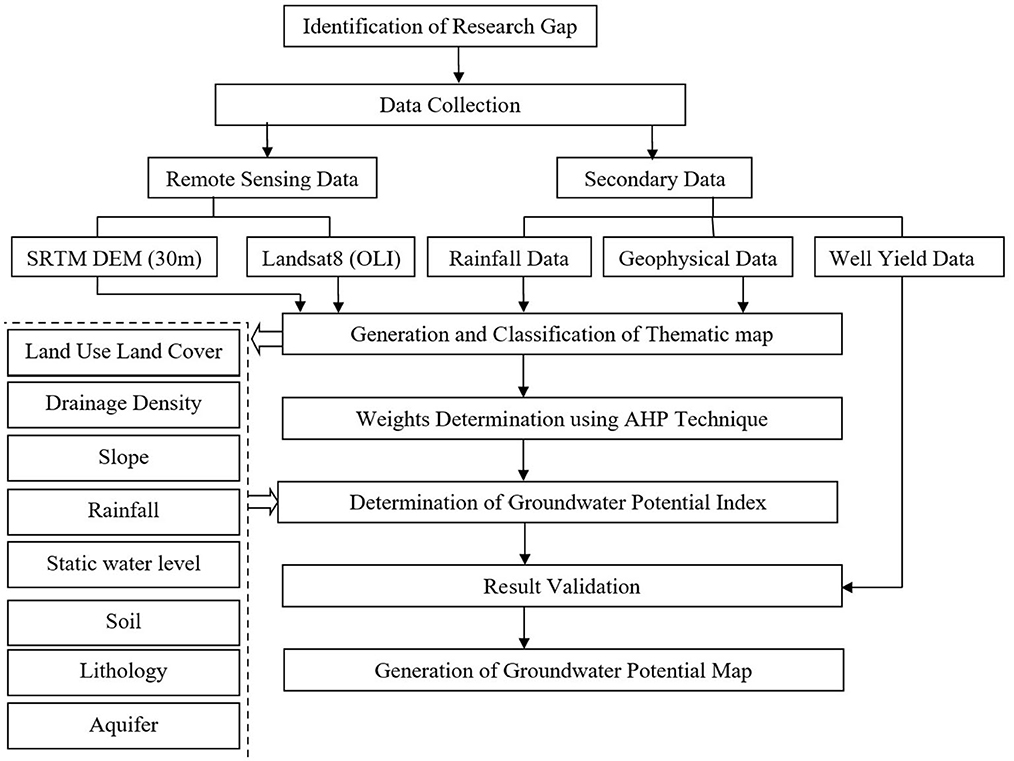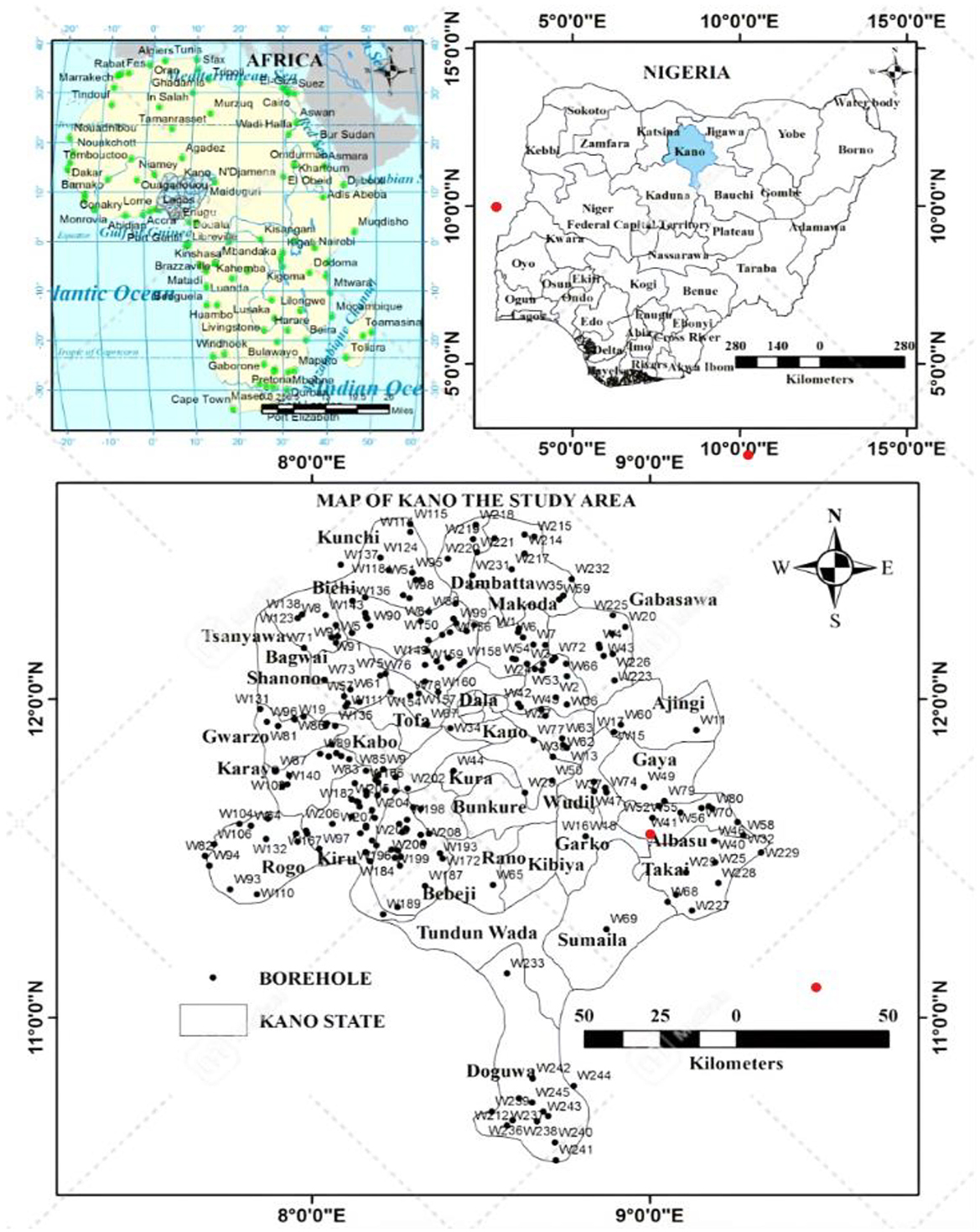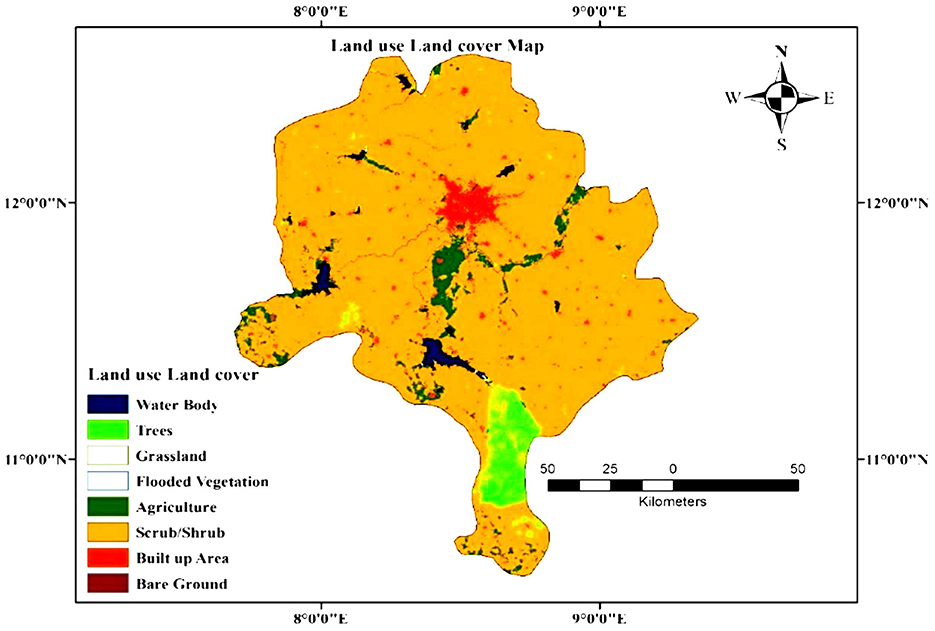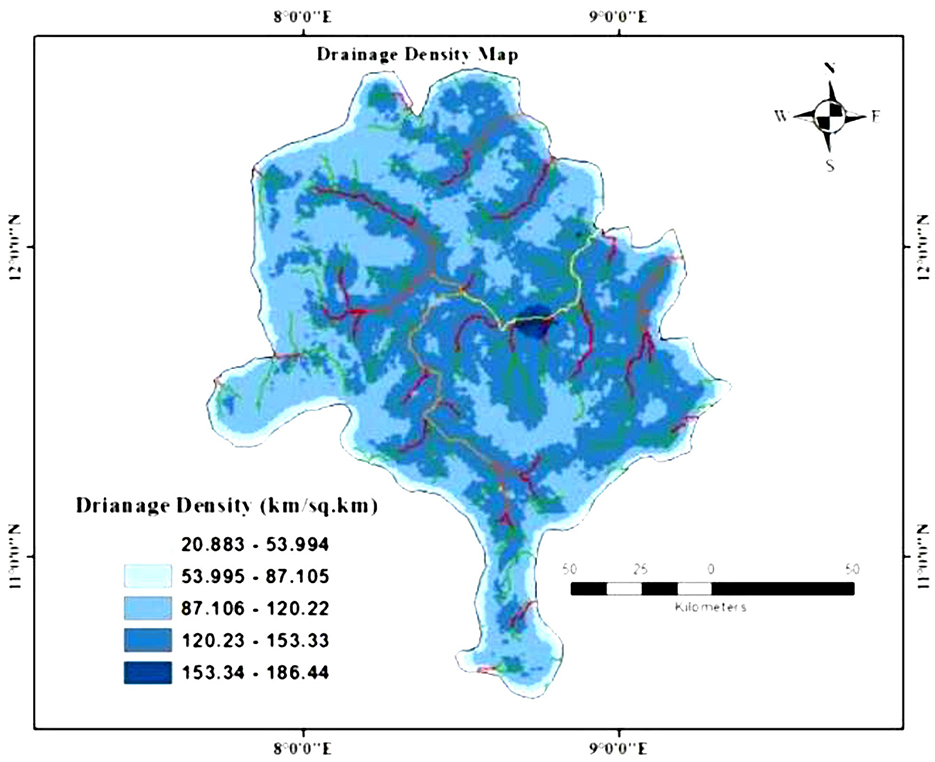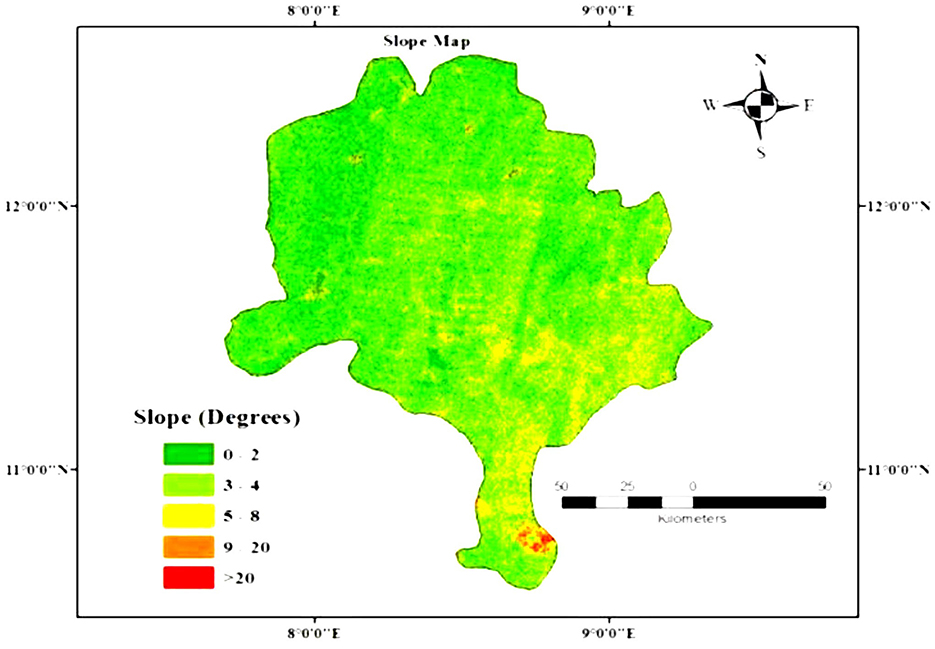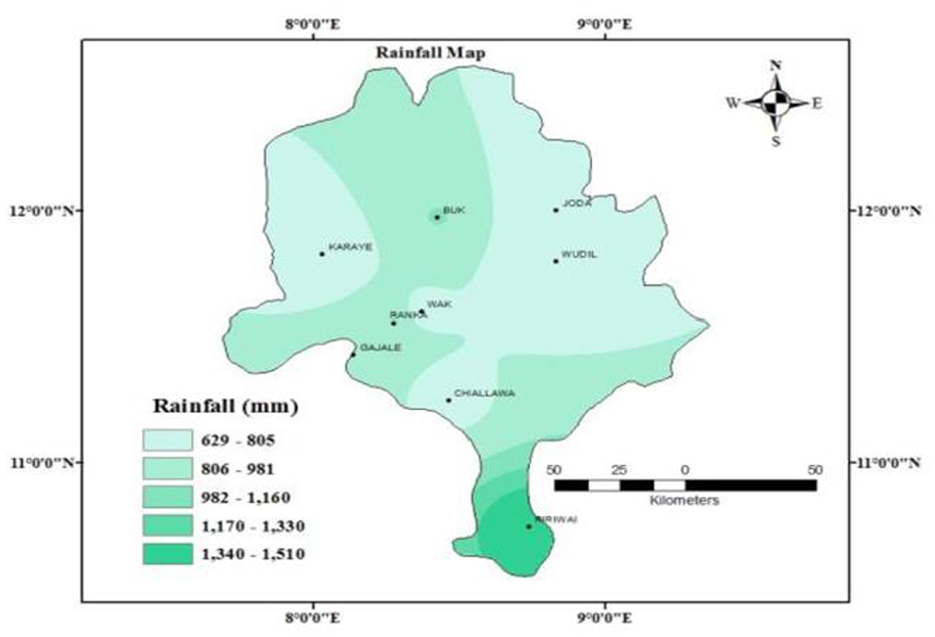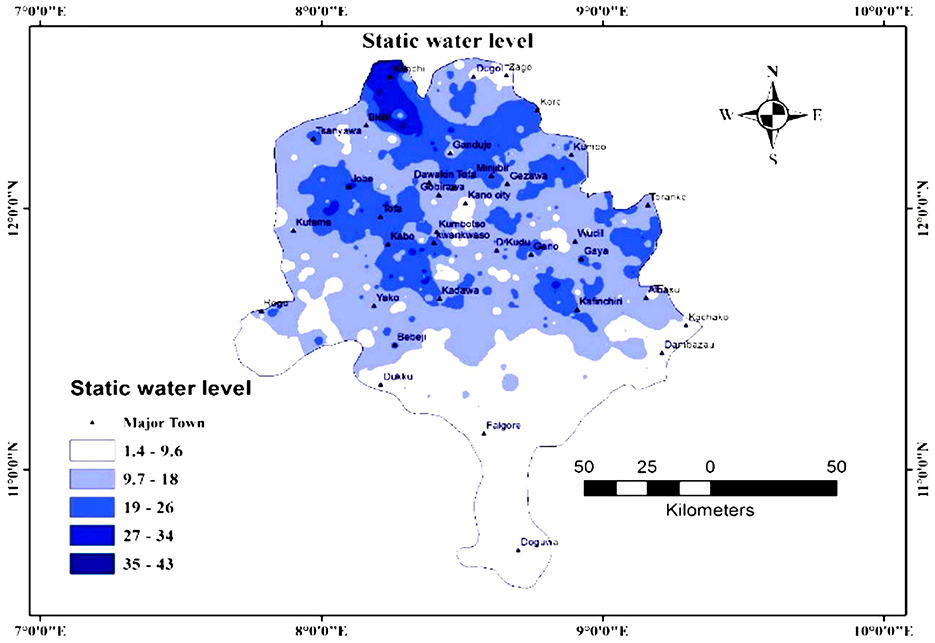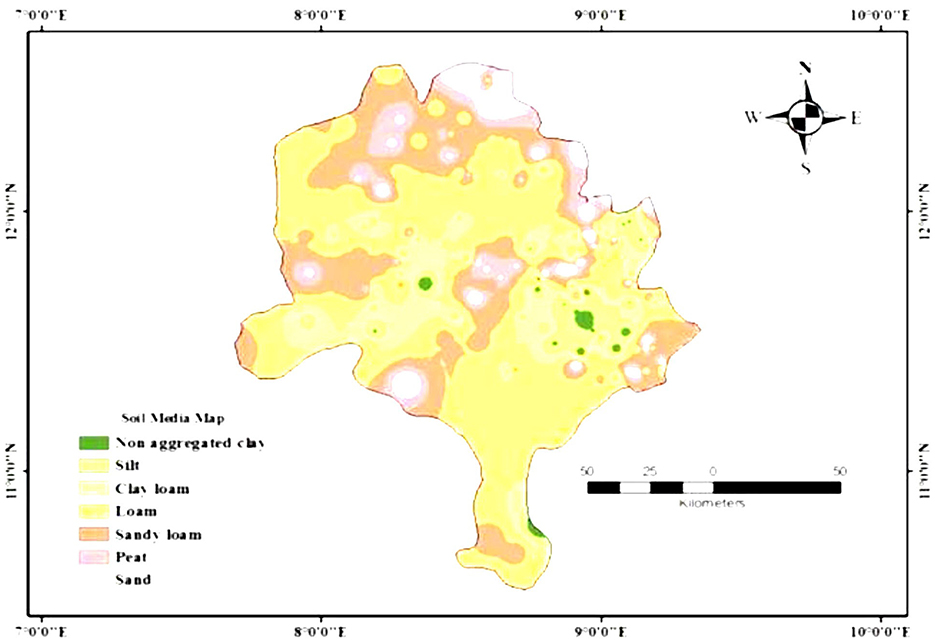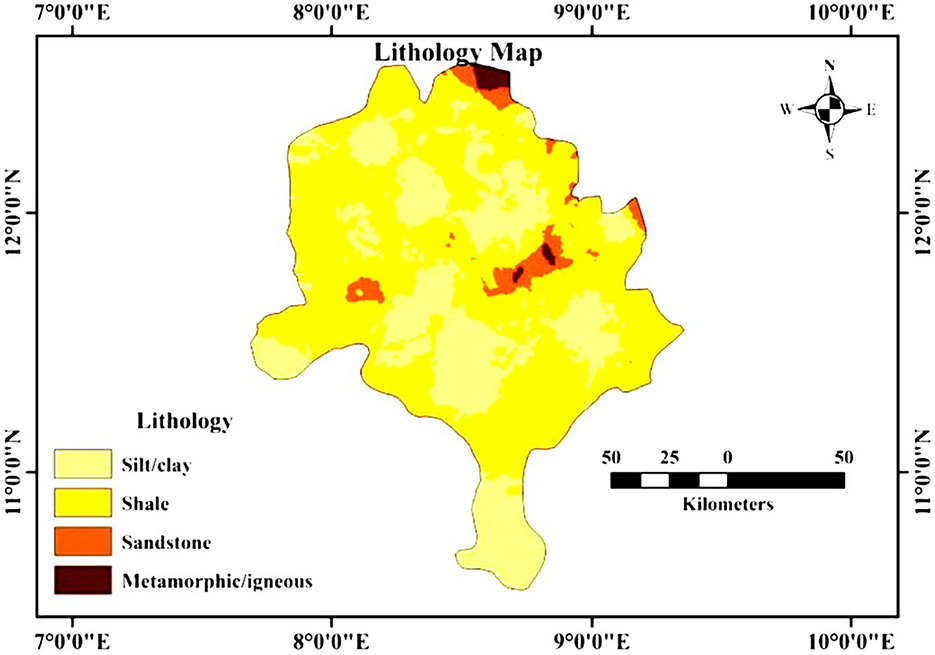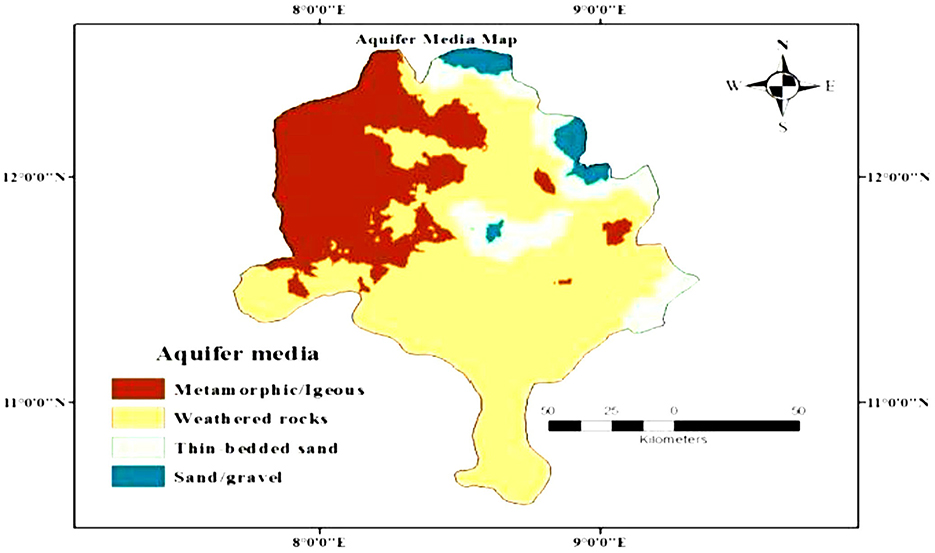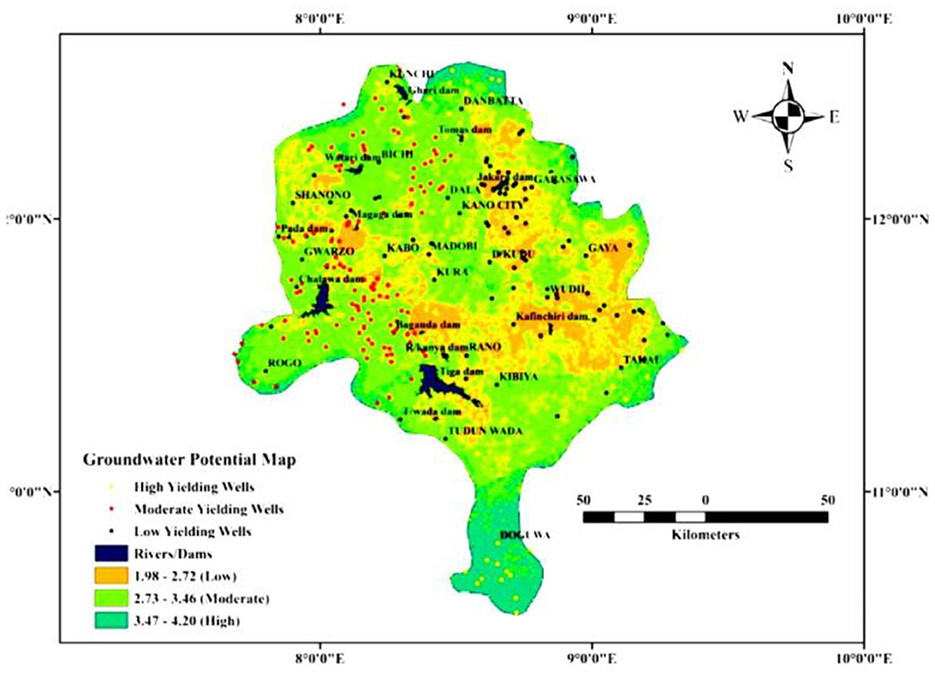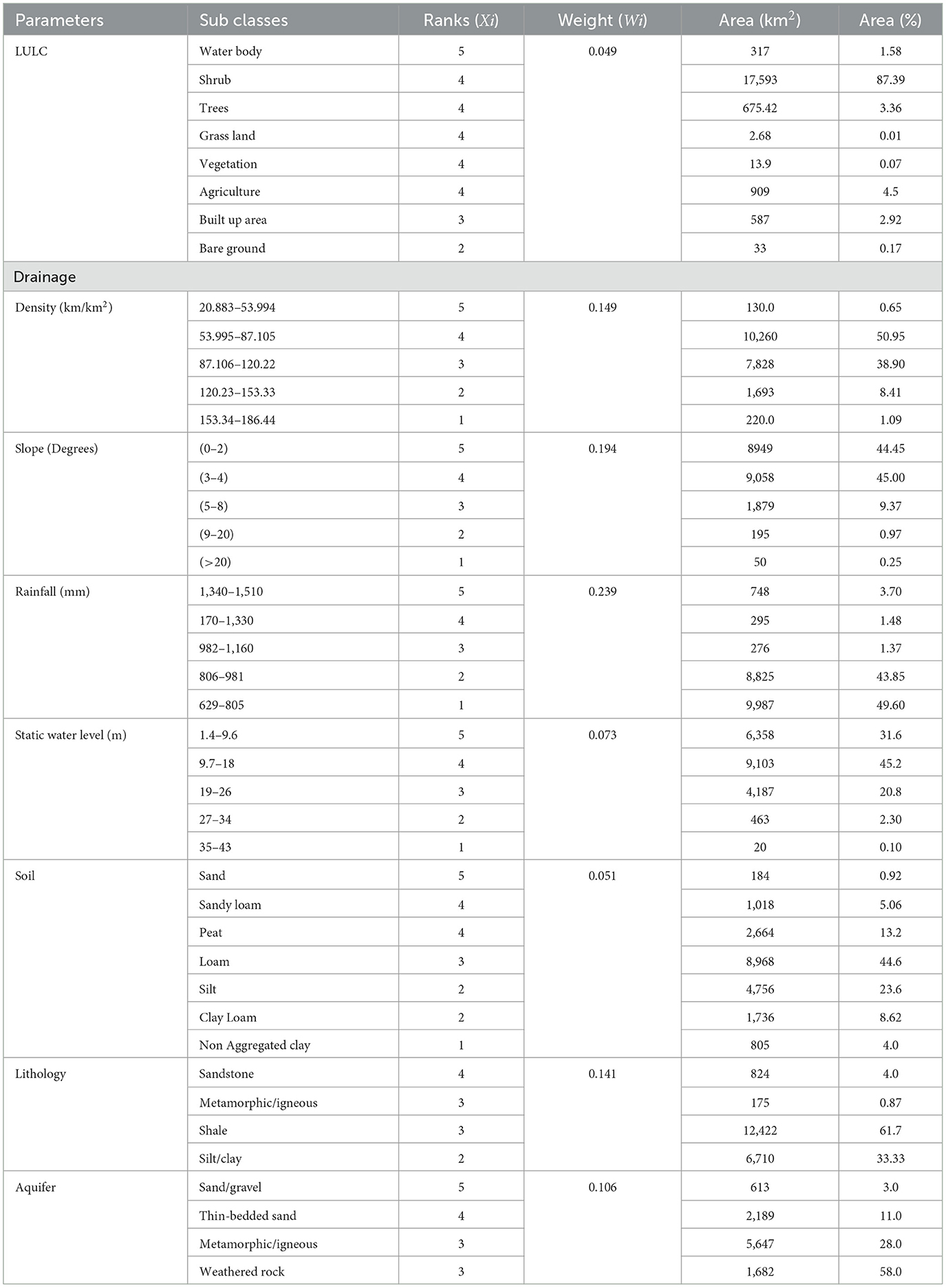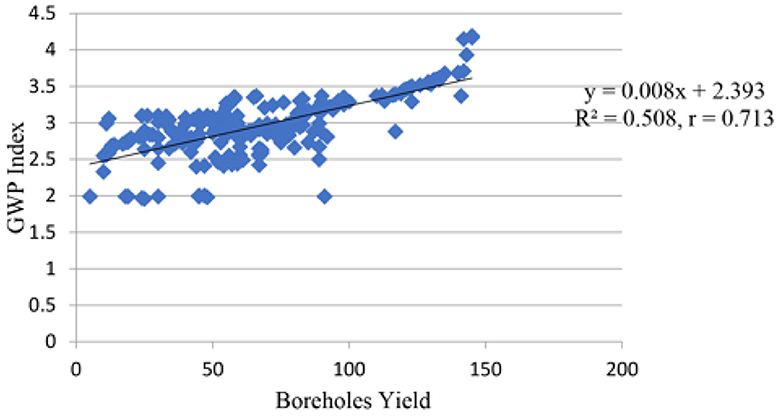- 1Department of Civil Engineering, Bayero University Kano, Kano, Nigeria
- 2Department of Civil Engineering, College of Engineering in Alkharj, Prince Sattam bin Abdulaziz University, Al-Kharj, Saudi Arabia
- 3Department of Civil Engineering, Prince Mohammad bin Fahd University, Al Khobar, Saudi Arabia
- 4Department of Civil Engineering, Hussaini Adamu Polytechnic, Kazaure, Jigawa, Nigeria
Groundwater resource management in drylands, characterized by climate variability and population growth, is difficult. Exploration and exploitation of groundwater, due to inadequate surface water is very costly. This study employed the analytic hierarchy process (AHP) and GIS to identify groundwater potential (GWP) areas in a semi-arid region of Nigeria. Land-use-land-cover, drainage density, slope, rainfall, static water level, soil, lithology, and aquifer were selected for GWP analysis. Parameter weights were determined using AHP and ranked based on their contribution to GWP by experts. The parameters were then integrated using the weighted overlay tool in ArcGIS 10.5 to produce a GWP map of the study area. Borehole yield data from 245 wells were collected to determine the model accuracy and model validation. Results classified the study area into very high GWP (1.9%), high GWP (8.8%), moderate GWP (62%), low GWP (20.70%) and very low GWP (6.6%). Areas with better GWP include Gurun, Dugol, Zago, Kumbo, Dukku, Doguwa, Riruwai, Dambazau, etc. Moderate GWP areas are widely spread across the state while areas with poor GWP include Sharawa, Kadewa, Koya, Dagar, Jigilawa, Galwanga, Yanganau, Kunchi, Tofa, Tsanyawa, etc. Validation of the AHP model with borehole yield data shows a correlation coefficient of 71.3% giving a good prediction. AHP and GIS can be used to successfully map GWP areas which could serve as an exploration guide for sustainable management of groundwater resources in semi-arid areas.
1 Introduction
Socio-economic activities, sustainability, and wellbeing of the human population rely on freshwater supply (Griggs et al., 2013). Water security is a serious issue that has hampered the attainment of the United Nation's Sustainable Development Goals (UN-SDGs) in many countries (van Vliet et al., 2021; Zeng et al., 2013). Statistics have shown that 5.52 billion people from 186 countries face water insecurity today (Nkatha, 2024). Of this number, 40% live in Sub-Saharan Africa (UNICEF and WHO, 2019). Jones et al. (2024) indicated that 47% of the world's population is exposed to water scarcity while 47% is affected by a lack of clean water at least 1 month per year. Li et al. (2024) show that over half of China's population face water scarcity for at least 1 month annually. Numerous inter-state conflicts over transboundary rivers have been reported (CNA, 2017). For several years, concerted efforts have been made all over the world for the efficient conservation and management of surface water (Pirone et al., 2024; Errico et al., 2019). However, the scarcity of surface water sources, together with a decline in the quality and quantity of such resources in arid and semi-arid environments intensified reliance on groundwater for domestic and agricultural use (Akujieze et al., 2003). There is also the problem of surface water pollution due to anthropogenic activities and lack of wastewater treatment (Dan'azumi and Bichi, 2010). By 2030, about 250 million people in Africa may experience high water stress (Groth et al., 2020; Mpandeli et al., 2020). The increasing level of freshwater demand due to the ever-growing population necessitates more attention on groundwater sources in many communities (Roy et al., 2020; Tarhule, 2007).
Ground-based geophysical surveys give precise information on the groundwater potential (GWP) of an area, but the method is expensive and time-consuming for a large area. This calls for a cost-effective multi-criteria decision-making approach in conjunction with remote sensing technology and geographic information system (GIS) for the identification of potential groundwater resource areas that could pave the way for effective and sustainable groundwater exploration and exploitation initiatives (Abdullateef et al., 2021). Remote sensing has been employed by many researchers in the prediction of natural changes on the earth's surface (Mohammad et al., 2023). Due to the importance of groundwater, researchers have worked a lot and proposed other alternative methods to groundwater exploration. Some examples include the works of Feng et al. (2024), Guo et al. (2023), Pharm et al. (2022), and Azari et al. (2021) among many others. Groundwater is normally recharged from surface water and therefore has high sensitivity to the presence of surface water sources (Crimaldi and Lama, 2021; Box et al., 2021; Lama and Crimaldi, 2021). Groundwater occurrence and distribution in a geographical location depend on the anthropogenic, physiographic, and climatic factors affecting the hydrological conditions of the area. Analyzing the relationship and overall influence of such factors on groundwater availability is essential for the effective prediction of the GWP of an area (Rahmati et al., 2015).
In their quest for a suitable prediction methodology of potential groundwater areas through modeling the effects of physiographic variables on hydrologic parameters to achieve sustainable groundwater management, hydrogeologists found the method of analytic hierarchy process (AHP) as one of the multi-criteria decision analysis models useful for effective groundwater management (Jha et al., 2010; Madrucci et al., 2008). The method provides a means for dealing with complex spatial decision problems by decomposing the spatial decision problem into a hierarchy of sub-problems for easy comprehension and subjective evaluation (Cabrera and Lee, 2019). The AHP is an Eigenvalue approach to pair-wise comparisons to calibrate the numeric scale for the measurement of quantitative as well as qualitative performances. The scale covers the entire spectrum of comparison from 1/9 for “least important than”, to 1 for “equal important than”, and to 9 for “strongly more important than” (Vaidya and Kumar, 2006). The method is one of the foremost decision-making models that is being applied to solve a countless number of real-world problems (Brunelli, 2015).
Nithya et al. (2019) studied the influence of geology, lineaments, geomorphology, slope, drainage density, soil, and rainfall on the GWP of Chittar Basin India, using GIS-based AHP. Results were validated using the groundwater yield of 24 open wells. The GWP map classified the areas into very good, good, medium, poor, and very poor GWP. Ifediegwu et al. (2019) used integrated remote sensing (RS), GIS, and AHP to study the influence of eight thematic maps (geology, rainfall, geomorphology, slope, drainage density, soil, land use land cover (LULC) and lineament density) on GWP in Lafia, Nigeria. Validation was done using data from 50 boreholes. Results classified 19.3, 12.9, 57.8, and 10% of the study area into good, moderate, poor, and very poor GWP areas. Kamaraj et al. (2023) integrated remote sensing and GIS to determine the effect of 15 parameters (i.e. geology, geomorphology, lineament density, topsoil resistivity and thickness, weathered zone resistivity and thickness, first fractured resistivity and thickness, second fractured resistivity and thickness, slope, LULC, drainage density and rainfall) on GWP of Mettur taluk, Salem district and Tamil Nadu, India. Results showed that topsoil thickness, pediment, lithology, slope type, and rainfall as the predominant factors influencing groundwater potential. Ally et al. (2024) combined seven thematic map layers of lithology, soil types, lineament, magnetic intensity, slope, drainage density, and elevation to develop a GWP zone map of Mpwapwa District, Tanzania. The resulting GWP zone was validated using the area under the curve and overlaying method. It was shown that 19% of the area was classified as very good, 31% as good, 28% as moderate, 22% as poor, and 2% as very poor GWP zones.
Other models used by researchers, in combination with GIS, include those for groundwater vulnerability assessment such as the DRASTIC model. DRASTIC represents seven (7) parameters used to describe the influence of geology and hydrogeology of an area in the model: D (depth of water), R (net recharge), A (aquifer media), S (soil media), T (topography), I (impact of the vadose zone), and C (hydraulic conductivity) (Fritch et al., 2000; Hamza et al., 2007; Jamrah et al., 2008).
Research has also been carried out to compare AHP with other approaches. Razandi et al. (2015) compared the use of AHP, frequency ratio, and certainty factor to map the GWP of Varamin Plain, Tehran Iran. Receiver operating characteristic was used to determine the accuracy of the GWP maps and results indicated that the frequency ratio outperformed both the AHP and certainty factor methods. Kaur et al. (2019) used remote sensing and GIS to compare AHP with Catastrophe theory for the demarcation of GWP zones in the Panipat district, India. Results showed that the percentage of area covered by each model is almost the same, thus the two models can be used for delineation of GWP areas. Shekar and Mathew (2023) combined slope, drainage density, rainfall, geomorphology, LULC, curvature, soil, topographic wetness index, distance from the river, and elevation as thematic layers and used AHP and fuzzy-AHP in a GIS environment to assess GWP zones in Murredu river basin, India. The zones were classified as poor, moderate, and good GWP areas.
AHP has been used, in GIS environments, by many scholars in the prediction of GWP areas to explore groundwater resources (Aluko and Igwe, 2017; Fashae et al., 2014; Ifediegwu et al., 2019; Igwe et al., 2020; Pinto et al., 2017; Rahmati et al., 2015; Roy et al., 2020; Elsebaie and Kawara, 2024). The approach has proven to be a reliable means of facilitating, interpreting, analyzing large volumes of diverse dataset which are then modeled through analytic procedure to produce useful information for use by authorities concerned (Guru et al., 2017). For this purpose, the present study employed AHP, using remote sensing and GIS, to integrate hydro-geological and climatic data to assess and map GWP areas which could serve as an exploration/exploitation guide for efficient and sustainable management of groundwater resources in Sub-Saharan Africa and other places with similar geology. The use of AHP in combination with remote sensing and GIS is novel in this part of the world as information is scarce in sub-Saharan Africa. The research will provide policymakers on the best way to sustainably manage the groundwater in the similar areas.
2 Materials and methods
Figure 1 shows the methodology flowchart, which will be explained in detail in the following subsections.
2.1 Study area
The study area is located in Kano state, northern part of Nigeria, West Africa. The area lies between latitudes 10°23′ 40′′ and 12°34′24′′ North, longitudes 7°41′ 15′′ and 9°21′ 21′′ East (Figure 2). Mean annual rainfall is 635 mm in the north and 1,000 mm in the south and occurs between May and October (Hamza et al., 2017). The total areal coverage of Kano state is estimated at 20,131 km2 which is mostly underlain by a crystalline basement rock and the remaining area is comprised of a sedimentary formation (Bala et al., 2011) (Supplementary Figure 1). The Northern Nigerian basement complex comprises migmatites and high-grade gneisses; the younger metasediments of upper proterozoic age and the older granite series (McCurry, 1989). The sedimentary formation consists largely of unconsolidated sandy sediments. Aquifers exist in three known layers in which the two top layers are accessible to borehole exploitation (Tukur et al., 2018). Hazell et al. (1988) also report the occurrence of rocks of the younger granites series as well as volcanics, and occasional younger dykes and flows. The lithology of the area shows three layers consisting of a topsoil layer with a thickness varying from 1.12 to 11.5 m, a weathered layer with a thickness varying from 5.29 to 54.34 m, and a fractured/fresh basement layer with a thickness varying from 23.18 to 68.60 m (Tahir et al., 2014).
Kano state is the most populous state in Nigeria with a population density of 764/km2. The 2023 population of the state is about 15,462,200 people with an annual growth rate of 3.2% (NPC, 2023). During the 2010–2013 period, there was a steady annual decrease of groundwater level. Groundwater beneath the floodplains dropped from 9,000 to 5,000 million cubic meters from 1964 to 1987 in the Chad Formation area of the region (Tukur et al., 2018). Surface water is not readily available to abstract, treat, and supply to communities which puts more pressure on groundwater sources. There is indiscriminate drilling of boreholes in the state and this results in the decline of water tables as more boreholes and wells dry up. This underscores the need to have an assessment of the groundwater with a view to sustainably manage it.
2.2 Data collection
The administrative boundary map, in shape file format, downloaded from DIVA-GIS (http://www.divagis.com), was employed for the generation of study area extent. Satellite imagery of LandSat 8 OLI and Shuttle Radar Topographical Mission Digital Elevation Model (SRTM DEM) both having 30 m spatial resolution were obtained from the United States Geological Survey website (http://www.glovis.usgs.com). Two hundred and forty-five (245) sets of borehole log data spread across the study area, were obtained from the archives of the Kano State Agricultural and Rural Development Authority (KNARDA) (1989). The borehole log data was collected by Wardrop Engineering Inc., the company that was contracted to carry out the drilling exercise. The borehole log data was used to generate a hydrogeological profile of the study area. The boreholes were ranked according to their yield in the order W1 to W245 with W1 having the lowest yield and W245 the highest. Also, rainfall data from nine (9) meteorological stations was obtained from the Kano State Water Board.
2.3 Data processing
For the remotely sensed data, the administrative boundary data was processed in an ArcGIS environment to mask Kano State as shown in Figure 2. Landsat 8 OLI images were clipped to the study area and ERDAS 9.0 was used for the satellite image processing. Land-use-land-cover (LULC) was interpreted using a visual interpretation technique and supervised classification of maximum likelihood classification was carried out for the final LULC map. For this study slope steepness and stream network information were deduced from SRTM DEM having 30 m spatial resolution, while the stream network information was consecutively processed to produce flow direction information for the surface drainage, flow accumulation information, stream order information, and finally, generating drainage density map for the study area.
The rainfall distribution map of the area under study was produced from the rainfall data of nine meteorological stations across the study area ie (Challawa, Karaye, Gajale, Riruwai, Wudil, Ranka, Joda, Wak, and BUK) using inverse distance weighting (IDW) interpolation method. While available information on static water level, soil, lithology, and aquifer, obtained from the KNARDA, was used to produce the static water level, soil, lithology, and aquifer maps of the study area respectively.
2.4 Analytic hierarchy process (AHP)
The AHP is a multi-criteria decision-making process involving experts ranking the relative importance of some chosen parameters. Structured interviews were done with 25 experts from universities and water resource institutes within the study region in the month of March, 2023. The background of experts covers the field of hydrogeology and water resources engineering. The questionnaire, shown in Supplementary Table 1 was used to identify the relative importance of all selected criteria. This questionnaire was based on a scale of 1–9 (Supplementary Table 2) for the experts to assess the relative importance of each individual criteria.
The steps involved in AHP are as follows:
Step 1: This step involves the identification of thematic layers. In this work, eight thematic layers of LULC, drainage density, slope, rainfall, static water level, soil, lithology, and aquifer were chosen.
Step 2: The experts' opinion was used to generate a pairwise comparison matrix (Table 1) based on their relative importance using Saaty's scale. Maps of the parameters were classified on a uniform rank of 1–5, where a scale of 1 denotes very low, 2 low, 3 implies moderate, 4 represents high and 5 denotes very high GWP (Mukherjee et al., 2012; Roy et al., 2020).
Step 3: Computations of the normalized weights utilizing the criteria's geometric mean (Gm) as shown in Equation 1. The normalized weights are presented in Table 2.
where Wn = Eigenvector of the matrix.
Step 4: The principal eigenvalue and Consistency Index (CI) were calculated to capture the uncertainty in experts' judgments using Equation 2:
where λmax = largest eigenvalue from the pairwise comparison matrix and = number of classes. The consistency of the pairwise comparison matrix was measured using a Consistency Ratio (CR) given by Equation 3:
where RI = random consistency index = 1.41 when n = 8 (Saaty, 1980).
Step 5: The resulting thematic maps of LULC, drainage density, slope, rainfall, static water level, soil, lithology, and aquifer were integrated according to Equation 4 using the weighted overlay method in ArcGIS 10.5 to generate an index value signifying the level of GWP per each cell.
where GWPI = the GWP index, Wi = the determined weight of each thematic layer. Xi = the ranks for the classes within each thematic layer.
Model validation is done using various approaches such as coefficient of determination (R2), percentage bias, Nash-Sutcliffe efficiency, and correlation coefficient (r) (Opere et al., 2022; Azari and Asadi, 2017; Moriasi et al., 2007). The prediction accuracy of this model was determined and the proposed GWP map was validated with recorded borehole yield data using the Pearson correlation coefficient (r) and to serve as an easy guide for the assessment of groundwater availability within the study area (Equation 5).
where xi is the respective borehole yield value at a particular point, is the mean borehole yield, yi is the GWP index value at that point and is the mean of the GWP index values. The R2 value was determined using Equation 6:
R values may range between −1 to +1. For r values between 0 and ±0.3, there is a weak relationship, ±0.3 to ±0.7 indicate a moderate relationship. Values between ±0.7 to ±1.0 indicate a strong linear relationship (Ratner, 2009; Schober et al., 2018). R2 values range between 0 and 1. Values between 0 to 0.2 indicate no relationship, 0.2 to 0.4 indicate a moderate relationship, 0.4 to 0.6 indicate a strong relationship, 0.6 to 0.8 indicate a very strong relationship, and values above 0.8 indicate a perfect relationship.
3 Results
3.1 LULC
LULC of an area controls hydrological processes of evapotranspiration, infiltration and surface runoff, which largely govern the occurrence and distribution of groundwater resources (Kaliraj et al., 2014). The LULC map of the study area (Figure 3) shows water bodies, trees, grassland, vegetation agriculture, and shrubs covering a total area of 317 km2 (1.58%), 675.42 km2 (3.36%), 2.68 km2 (0.0134%), 13.90 km2 (0.070%), 909 km2 (4.5%) and 17,593 km2 (87.39%) respectively. These dominant land uses promote infiltration which leads to high groundwater prospects. The built-up area and bare ground occupy only 587 km2 (2.92%) and 33 km2 (0.15%) respectively.
3.2 Drainage density
Drainage density of an area defines the sum of the drainage channel lengths per unit area. Drainage basins having high drainage density results in low infiltration within its subsurface formation and hence, low groundwater prospect (Singh et al., 2013). In the study area, the high and very high drainage density areas constitute 10,390 km2 (51.60%), moderate 7,828 km2 (38.90%) while low and very low drainage density covered only 1,913 km2 (9.50%) of the study area (Figure 4). This low to very low drainage density zones implies high infiltration and recharge potentials which is a function of high groundwater prospect (Roy et al., 2020).
3.3 Slope
The slope is an aspect of geomorphologic features. Its nature along with other geomorphic features play a significant role in determining infiltration and potential groundwater recharge in an area. The slope of the study area as illustrated in Figure 5 revealed that about 18,007 km2 (89.50%) of the area is covered by a slope of < 5 degrees signifying a nearly level and gentle surface which gives a high infiltration rate and high probability of groundwater prospect. 879 km2 (9.30%) is covered by (5–8) degrees moderately sloping, 195 km2 (0.95%) is covered by (9–20) degrees slightly steep sloping while 50 km2 (0.25%) of the area is covered by >20 degrees steep slope leading to less rainfall/runoff infiltration and less probability of groundwater prospect (Jaiswal et al., 2003).
3.4 Rainfall
Rainfall is a meteorological factor that contributes immensely to groundwater recharge. Understanding the nature and characteristics of rainfall of an area helps in predicting its effects on evapotranspiration, infiltration and surface runoff. For hydrological analysis, areal distribution of rainfall is required to create potential groundwater areas (Fashae et al., 2014). The distribution of rainfall in the study area ranges from 629 mm to 1,510 mm with reference evapotranspiration of 5.88 mm/day. The aridity index of Kano is 0.49 suggesting a seasonally semi-arid climate with a mean annual rainfall decreasing toward the north (Ogunrinde et al., 2019; Hamza et al., 2019). The rainfall map (Figure 6) reveals that about 1,043 km2 (5.18%) received a high amount of rainfall which signifies good GWP, 276 km2 (1.37%) moderate, while 18,812 km2 (93.45%) received a low amount of rainfall suggesting poor GWP.
3.5 Static water level
Static water level is a measure of the distance from the ground surface to the water level and a parameter that determine the potential distance for water to travel to the aquifer. Variation in static water level within the study area shows a change ranging from 1.4-9.6 m covering 6358 km2 (31.6%), as very high, 9.7–18 m covering 9,103 km2 (45.2%) as high, 19–26 m covering 4,187 km2 (20.8%) as moderate, while 27–34 m covering 463 km2 (2.30%) and 35–43 m covering 20 km2 (0.10%) as low and very low groundwater prospective areas respectively (Figure 7).
3.6 Soil
Soil is an influencing factor that facilitates infiltration of rainfall and represents surface features that control the amount of recharge into the saturated zone. The depth of the soil ranges from the surface up to 10 m deep. The soil types in Figure 8 include sand, sandy loam and peat covering 3,866 km2 (19.18%) which allow water to infiltrate easily due to high permeability suggesting high groundwater prospect area, loamy soil covers an area of 8,968 km2 (44.6%) and non-aggregated clay, clay loam and silt covered 7,297 km2 (36.22%) which imply limited infiltration because of low permeability and hence, low groundwater prospect (Fashae et al., 2014).
3.7 Lithology
The lithological unit plays an important role in transmitting the water to the lower layer (aquifer media). This unsaturated zone of the study area (Figure 9) is underlain by basement complex rocks and sedimentary formation. Only 824 km2 (4.1%) of the study area is covered by sandstone which allows high infiltration due to its high porosity hence, suggesting high groundwater availability. Metamorphic/igneous and shale formations covered 12,597 km2 (62.6%) giving moderate infiltration and silt/clay covered 6,710 km2 (33.3%) allowing low infiltration suggesting a low probability of groundwater prospect (Ifediegwu et al., 2019).
3.8 Aquifer
Aquifer properties control the rate at which groundwater flows within an aquifer formation. Figure 10 shows that the aquifer formation in the study area comprises thin-bedded sand and sand/gravel formations occupying 2,189 km2 (11%) and 613 km2 (3%) respectively, suggesting high groundwater prospects. The metamorphic/igneous and weathered rocks occupy 5,647 km2 (28%) and 11,682 km2 (58%) suggesting moderate GWP.
3.9 GWP map
The GWP map in Figure 11 was generated according to Equation 4 by weighted overlay analysis of the determined weights of each of the groundwater controlling parameters. The map was assigned ranks for the sub-class of each parameter (Table 3). The factors were ranked on a scale of 1–5, where a scale of 1 denotes very low, 2 low, 3 implies moderate, 4 represents high and 5 denotes excellent GWP as adopted by Jha et al. (2010), Mukherjee et al. (2012), and Roy et al. (2020). The GWP map was classified into very low covering 1,320 km2 (6.60%), low 4164 km2 (20.70%), moderate 12,482 km2 (62.0%), high 1,783 km2 (8.80%), and very high covering 382 km2 (1.90%) of the study area (Figure 11).
The classified boreholes yield data in Table 4 were superimposed on the GWP map which was obtained using the RS-GIS and AHP methods. The results show that out of 80 boreholes with (ID No W1 to W80) classified as low-yielding wells (yield < 50 l/min), 67 fall within very low to low GWP categories representing 83.8% accuracy. Out of the 129 wells with (ID No W81 to W209) classified as moderate yielding wells (with yield between 50 l/min to 100 l/min), 82 fall within the moderate GWP category representing 63.6% and likewise, out of the 36 wells with (ID No W210 to W245) classified as high yielding wells (with yield > 100 l/min), 28 fall within the high and very high GWP representing 77.8% accuracy. The overall accuracy is thus 74.4 percent (Figure 11). With a good correlation coefficient of 71.3 % and prediction accuracy of 74.4%, it is evident that AHP can be used to predict the GWP of areas as a surrogate measure for borehole yield.

Table 4. Classification of boreholes yield of the study area in comparison with (Fashae et al., 2014).
3.10 Model validation
Validation is the most important process of a model without which models lack scientific significance (Chung and Fabbri, 2003). For validation, the Pearson Correlation Coefficient was employed to compare the recorded borehole yield data with the GWP index value obtained by the AHP model. The plot assessment shows a correlation coefficient of 0.713 indicating a strong prediction. Also, the R2 value of 0.508 indicates a strong relationship between borehole yield and the GWP index (Ratner, 2009; Schober et al., 2018) (Figure 12).
4 Discussion
Globally, the problem of stress on freshwater supply is a well-documented issue. This problem is exacerbated by climate change which manifests itself in drought in some parts of the world. Highly populated areas, such as Kano, become more vulnerable arising from the over-abstraction of water sources due to high water demand from the high population of about 15,462,200 persons (NPC, 2023). Surface water pollution and grossly insufficient municipal water supply have led to the demand for groundwater in the state (Akujieze et al., 2003; Tukur et al., 2018). The United Nations Sustainable Development Goal No. 6 (SDG 6) attempts to address this issue and Nigeria is not on track to achieve this by 2030 as only 29% of the population uses safely managed drinking water sources (UN World Water Development Report, 2022). Other targets related to SDG 6 are also below 50% which is far from the expectations. The country has to fast-track the implementation of policies to achieve this aim.
The geology of the study area is mostly comprised of the crystalline basement complex rock and the remaining is sedimentary formation. Generally, water in the basement complex area is higher relative to the water table in the Chad formation. Mustapha et al. (2014) have pointed out the basement complex areas of Kano have water levels generally varying from 6 m to 25 m which rarely reach up to 50 m in some places. In contrast, the Chad Formation has a water table ranging from 20 m to 50 m. A sharp decline in groundwater levels calls for research on groundwater sustainability. AHP was integrated into RS and GIS to delineate and map GWP areas. Eight thematic layers affecting groundwater recharge potential including LULC, drainage density, slope, rainfall, static water level, soil, lithology, and aquifer were chosen in this research.
Landsat-5 Thematic Mapper I imageries were used in groundwater exploration in the basement complex rocks of the Kano, Zaria, and Kaduna areas. It was found that areas with high fracture density have high groundwater potential (Bala, 2001). Olorunfemi and Fasuyi (1993) delineated the aquifer types in the study area. These aquifer types include; weathered layer aquifer, weathered/fractured or partly weathered aquifer, and fractured aquifer. Bala et al. (2011) examined the regolith aquifers derived from different bedrock types in the basement complex of Kano using the information on the depth of borehole, static water level, yield, and drawdown of 259 boreholes covering different rock types. Their result shows that the mean depth of the borehole varies from about 37 m to 48 m in rocks of the younger granites and the migmatites-gneiss complex and schists, respectively. Isa (1984) investigated the hydraulic properties of the basement complex and Chad formation aquifers of Kano State based on pumping tests of selected boreholes. In the basement complex areas, an average transmissivity was 12.32 m2/day, hydraulic conductivity was 0.33 m/day and specific capacity was 0.36 m3/m of drawdown. Strong variation in the water levels is attributed to topography, overburden thickness, and geology. Aquifers are found in the weathered layer where it is extensively thick while the bedrock also serves as an aquifer where it is extensively fractured (Tahir et al., 2014). The aquifers comprised both confined and unconfined found in both the weathered and the fractured rocks (Yola and Ismail, 2012; Ismail and Yola, 2012; Idris et al., 2020; Yelwa et al., 2015).
Results of the spatial analysis show that better groundwater prospective areas occupied a total area of 2,165 km2 (10.70%) and were mostly situated in Gurun, Dugol, Zago, Kumbo in the north and Dukku, Doguwa, Riruwai, Dambazau in the southern parts of Kano State. These are mainly attributed to the nature of the topography, drainage density, and rainfall and these areas could be suitable for groundwater development for agricultural utilization. These areas were represented as W210-W245. Moderate GWP areas are widely distributed across the study area and cover 12,482 km2 (62%) of the state and could be suitable for groundwater development for domestic use. These areas were represented as W81-W209. Meanwhile, poor GWP areas covered 5,484 km2 (27.30%) and are concentrated mostly in areas having high drainage density and low rainfall at central and southeastern parts of Kano state. The poor GWP include Sharawa, Kadewa, Koya, Dagar, Jigilawa, Galwanga, Yanganau, Zuwo, Garji Kadaye, Kankarawa, Kunchi, Tsanyawa, Jobe, Tofa, Kabo, etc. These areas were represented as W1-W80 (Figure 11, Supplementary Figure 2). These poor GWP areas could not be sufficient for groundwater development for commercial agriculture hence the need for surface water infrastructure to augment the existing water supply system. For sustainability, efforts should be stepped up to improve water supply, using surface water sources, in areas close to existing surface waters. This will go a long way in relieving the current pressure on groundwater.
5 Conclusion
Groundwater sources are known to be reliable in terms of quantity and quality. This is so particularly in arid areas where surface water is ephemeral. Water security issues are compounded in developing countries due to insufficient funds and lack of political will and technical know-how toward the conservation of the available surface water resources. Identification of GWP areas in arid environments was achieved through the use of an expert-based multi-criteria evaluation approach of AHP in a GIS environment. The result shows rainfall (23.9%) and slope (19.4%) as the most important factors contributing to GWP while LULC (4.99%) and soil (5.03%) exert the least significant impact. However, the developed model categorized the study area into very low 1,320 km2 (6.60%), low 4,164 km2 (20.70%), moderate 12,482 km2 (62.0%), high 1,783 km2 (8.80%), and very high 382 km2 (1.90%) groundwater prospective areas. Areas with better GWP include Gurun, Dugol, Zago, Kumbo, Dukku, Doguwa, Riruwai, Dambazau, etc. Moderate GWP areas are widely spread across the state while areas with poor GWP include Sharawa, Kadewa, Koya, Dagar, Jigilawa, Galwanga, Yanganau, Kunchi, Tsanyawa, Jobe, Tofa, Kabo, etc (Figure 11, Supplementary Figure 2). Consequently, the AHP model was validated with recorded borehole yield data to achieve a correlation coefficient of 71.3% and prediction accuracy of 74.4%. With fairly good model validation results, it is evident that the geospatial technology of RS-GIS and AHP technique can be employed to successfully map groundwater prospective areas which could serve as an exploration/exploitation guide for efficient and sustainable management of groundwater. In addition, for the long-term sustainability of water resources in the study area, an updated RS-GIS and AHP using adequate inventory data is recommended as well as the development of more surface water infrastructure in poor GWP areas to curtail the prevailing groundwater development in Nigeria and other regions with similar characteristics.
Data availability statement
The data analyzed in this study is subject to the following licenses/restrictions: the datasets are not publicly available. It was given to us on research request. Requests to access these datasets should be directed to Kano State Agricultural and Rural Development Authority. https://knarda.org/contact/.
Ethics statement
Ethical review and approval was not required for the study on human participants in accordance with the local legislation and institutional requirements. Written informed consent from the (patients/participants OR patients/participants legal guardian/next of kin) was not required to participate in this study in accordance with the national legislation and the institutional requirements.
Author contributions
AS: Conceptualization, Formal analysis, Investigation, Methodology, Software, Validation, Visualization, Writing – original draft, Writing – review & editing. AA: Funding acquisition, Project administration, Visualization, Writing – original draft, Writing – review & editing. SD: Formal analysis, Investigation, Methodology, Project administration, Supervision, Writing – original draft, Writing – review & editing. SA: Formal analysis, Software, Validation, Writing – original draft, Writing – review & editing. SH: Data curation, Resources, Visualization, Writing – review & editing.
Funding
The author(s) declare financial support was received for the research, authorship, and/or publication of this article. This work was supported by Prince Sattam bin Abdulaziz University (Project Number: PSAU/2024/R/1445).
Acknowledgments
The authors extend their appreciation to Prince Sattam bin Abdulaziz University for funding this research work through the project number (PSAU/2024/R/1445).
Conflict of interest
The authors declare that the research was conducted in the absence of any commercial or financial relationships that could be construed as a potential conflict of interest.
Publisher's note
All claims expressed in this article are solely those of the authors and do not necessarily represent those of their affiliated organizations, or those of the publisher, the editors and the reviewers. Any product that may be evaluated in this article, or claim that may be made by its manufacturer, is not guaranteed or endorsed by the publisher.
Supplementary material
The Supplementary Material for this article can be found online at: https://www.frontiersin.org/articles/10.3389/frwa.2024.1484753/full#supplementary-material
References
Abdullateef, L., Tijani, M. N., Nuru, N. A., John, S., and Mustapha, A. (2021). Assessment of groundwater recharge potential in a typical geological transition zone in Bauchi, NE-Nigeria using remote sensing/GIS and MCDA approaches, Heliyon 7:e06762. doi: 10.1016/j.heliyon.2021.e06762
Akujieze, C. N., Coker, S., and Oteze, G. (2003). Groundwater in Nigeria–a millennium experience–distribution, practice, problems and solutions. Hydrogeol. J. 11, 259–274. doi: 10.1007/s10040-002-0227-3
Ally, M. A., Yan, J., Bennett, G., Lyimo, N., and Mayunga, S. D. (2024). Assessment of groundwater potential zones using remote sensing and GIS-based fuzzy analytical hierarchy process (F-AHP) in Mpwapwa District, Dodoma, Tanzania. Geosyst. Geoenvironm. 3:100232. doi: 10.1016/j.geogeo.2023.100232
Aluko, O. E., and Igwe, O. (2017). An integrated geomatics approach to groundwater potential delineation in the Akoko-Edo Area. Nigeria, Env. Earth Sciences 76:240. doi: 10.1007/s12665-017-6557-1
Azari, A., and Asadi, M. (2017). Investigating the capabilities of the NSGA-II multi-objective algorithm in automatic calibration of the WEAP model for simulating Jareh Dam and network system. J. Appl. Res. Water Wastewater 4, 305–313. doi: 10.22126/arww.2017.775
Azari, A., Zeynoddin, M., Ebtehaj, I., Sattar, A. M., Gharabaghi, B., and Bonakdari, H. (2021). Integrated preprocessing techniques with linear stochastic approaches in groundwater level forecasting. Acta Geophys. 69, 1395–1411. doi: 10.1007/s11600-021-00617-2
Bala, A. E. (2001). An evaluation of Landsat-5 Thematic Mapper (TM) Data as a Tool for Groundwater Investigation in Basement Complex Rocks of Nigeria (PhD thesis). Department of Geology, A.B.U. Zaria, Zaria, Nigeria, 3–40.
Bala, A. E., Eduvie, O. M., and Byami, J. (2011). Borehole depth and regolith aquifer hydraulic characteristics of bedrock types in Kano area, Northern Nigeria. African J. Env Sci. Tech 5, 228–237. Available at: https://www.ajol.info/index.php/ajest/article/view/71936
Box, W., Järvelä, J., and Västilä, K. (2021). Flow resistance of floodplain vegetation mixtures for modelling river flows. J. Hydrol. 601:126593. doi: 10.1016/j.jhydrol.2021.126593
Brunelli, M. (2015). “Introduction to the analytic hierarchy process,” in Springer Briefs in Operations Research. Cham; Heidelberg; New York, NY; Dordrecht; London: Springer.
Cabrera, J. S., and Lee, H. S. (2019). Flood-prone area assessment using GIS-based multi-criteria analysis: a case study in Davao Oriental, Philippines. Water 11:2203. doi: 10.3390/w11112203
Chung, C.-J. F., and Fabbri, A. G. (2003). Validation of spatial prediction models for landslide hazard mapping. Nat. Hazards 30, 451–472. doi: 10.1023/B:NHAZ.0000007172.62651.2b
CNA (2017). The Role of Water Stress in Instability and Conflict. Arlington, VA: Center for Naval Analysis (CAN). Available at: https://www.cna.org/archive/CNA_Files/pdf/crm-2017-u-016532-final.pdf (assessed October 14, 2024).
Crimaldi, M., and Lama, G. F. C. (2021). “Impacts of riparian plants biomass assessed by UAV–acquired multispectral images on the hydrodynamics of vegetated streams,” in 29th European Biomass Conference and Exhibition.
Dan'azumi, S., and Bichi, M. H. (2010). Industrial pollution and implication on source of water supply in Kano, Nigeria. Intern. J. Eng. Technol. 10, 101–109.
Elsebaie, I. H., and Kawara, A. Q. (2024). Modeling groundwater recharge potential zones in the Wadi Yalamlam, Saudi Arabia. Front. Water 6:1387741. doi: 10.3389/frwa.2024.1387741
Errico, A., Lama, G. F. C., Francalanci, S., Chirico, G. B., Solari, L., and Preti, F. (2019). “Validation of global flow resistance models in two experimental drainage channels covered by Phragmites australis (common reed),” in Proceedings of the 38th IAHR World Congress-Water Connecting the World, 1313–1321.
Fashae, O. A., Tijani, M. N., Talabi, A. O., and Adedeji, O. I. (2014). Delineation of groundwater potential zones in the crystalline basement terrain of SW-Nigeria: an integrated GIS and remote sensing approach. Appl. Water Sci. 4, 19–38. doi: 10.1007/s13201-013-0127-9
Feng, F., Ghorbani, H., and Radwan, A. E. (2024). Predicting groundwater level using traditional and deep machine learning algorithms. Front. Environ. Sci. 12:1291327. doi: 10.3389/fenvs.2024.1291327
Fritch, T. G., McKnight, C. L., Yelderman, J. C., and Arnold, J. G. (2000). An aquifer vulnerability assessment of the Paluxy Aquifer Central Texas, USA, using GIS and a modified DRASTIC approach. Environ. Manag. 25, 337–345. doi: 10.1007/s002679910026
Griggs, D., Stafford-Smith, M., Gaffney, O., Rockström, J., Öhman, M. C., Shyamsundar, P., et al. (2013). Policy: sustainable development goals for people and planet. Nature. 495:305. doi: 10.1038/495305a
Groth, J., Ide, T., Sakdapolrak, P., Kassa, E., and Hermans, K. (2020). Deciphering interwoven drivers of environment related migration – A multisite case study from the Ethiopian highlands. Global Environm. Change 63:102094 doi: 10.1016/j.gloenvcha.2020.102094
Guo, B., Zhang, S., Liu, K., Yang, P., Xing, H., Feng, Q., et al. (2023). Prediction of groundwater level under the influence of groundwater exploitation using a data-driven method with the combination of time series analysis and long short-term memory: a case study of a coastal aquifer in Rizhao City, Northern China. Front. Environ. Sci. 11:1253949. doi: 10.3389/fenvs.2023.1253949
Guru, B., Seshan, K., and Bera, S. (2017). Frequency ratio model for groundwater potential mapping and its sustainable management in cold desert, India. J. King Saud Univers.-Sci. 29, 333–347. doi: 10.1016/j.jksus.2016.08.003
Hamza, M. H., Added, A., Rodríguez, R., Abdeljaoued, S., and Ben Mammou, A. (2007). A GIS-based DRASTIC vulnerability and net recharge reassessment in an aquifer of a semi-arid region (Metline-Ras Jebel-Raf Raf aquifer, Northern Tunisia). J. Environ Manage 84, 12–19. doi: 10.1016/j.jenvman.2006.04.004
Hamza, S. M., Ahsan, A., Imteaz, M. A., Ghazali, A. H., and Mohammed, T. A. (2017). GIS-based FRASTIC model for pollution vulnerability assessment of fractured-rock aquifer systems. Env. Earth Sci. 76:197. doi: 10.1007/s12665-017-6520-1
Hamza, S. M., Ahsan, A., and Sulaiman, W. N. A. (2019). GIS-based spatial analysis accurately predicts alluvial well depletion and effectively establishes relationship between aquifer parameters. Intern. J. of Water Res and Arid Env. 8, 49–60. Available at: https://icwrae-psipw.org/papers/2018/RemoteSensing&GIS/5.pdf
Hazell, J. R. T., Cratchley, C. R., and Preston, A. M. (1988). The Location of aquifers in crystalline rocks and alluvium in Northern Nigeria using combined electromagnetic and resistivity techniques. Q. J. Eng. Geol. 21:159175. doi: 10.1144/GSL.QJEG.1988.021.02.05
Idris, M. A., Rufa'i, S. A., and Dandogo, K. A. (2020). Characteristics and groundwater quality evaluation of Roni Area, Northwestern Nigeria. Nigerian J. Technol. Dev. 17. Available at: https://www.ajol.info/index.php/njtd/article/view/197830
Ifediegwu, S. I., Nnebedum, D. O., and Nwatarali, A. N. (2019). Identification of groundwater potential zones in the hard and soft rock terrains of Kogi State, North Central Nigeria: an integrated GIS and remote sensing techniques. SN Appl. Sci. 1, 1–15 doi: 10.1007/s42452-019-1181-1
Igwe, O., Ifediegwu, S. I., and Onwuka, O. S. (2020). Determining the occurrence of potential groundwater zones using integrated hydro-geomorphic parameters, GIS and remote sensing in Enugu State, Southeastern, Nigeria. Sustain. Water Res. Man 6, 1–14. doi: 10.1007/s40899-020-00397-5
Isa, M. (1984). Hydraulic Properties of Basement Complex and Chad Formation Aquifers of Kano State based on Test pumping of selected Boreholes (MSc Thesis). Geology Department Ahmadu Bello University Zaria, Zaria, 5–40.
Ismail, A. Y., and Yola, A. L. (2012). Geoelectrical investigation of groundwater potential of Dawakin Tofa local government area of Kano State Nigeria. Am. Int. J. Contemp. Res. 2. Available at: https://www.aijcrnet.com/journals/Vol_2_No_9_September_2012/22.pdf
Jaiswal, R. K., Mukherjee, S., Krishnamurthy, J., and Saxena, R. (2003). Role of remote sensing and GIS techniques for generation of groundwater prospect zones towards rural development–an approach, Intern. J. Remote Sens. 24, 993–1008. doi: 10.1080/01431160210144543
Jamrah, A., Al-Futaisi, A., Rajmohan, N., and Al-Yaroubi, S. (2008). Assessment of groundwater vulnerability in the coastal region of Oman using DRASTIC index method in GIS environment. Environ. Monit. Assess. 147, 125–138 doi: 10.1007/s10661-007-0104-6
Jha, M. K., Chowdary, V. M., and Chowdhury, A. (2010). Groundwater assessment in Salboni Block, West Bengal (India) using remote sensing, geographical information system and multi-criteria decision analysis techniques. Hydrogeol. J. 18, 1713–1728. doi: 10.1007/s10040-010-0631-z
Jones, E. R., Bierkens, M. F. P., and van Vliet, M. T. H. (2024). Current and future global water scarcity intensifies when accounting for surface water quality. Nat. Clim. Chang. 14, 629–635. doi: 10.1038/s41558-024-02007-0
Kaliraj, S., Chandrasekar, N., and Magesh, N. S. (2014). Identification of potential groundwater recharge zones in Vaigai upper basin, Tamil Nadu, using GIS-based analytical hierarchical process (AHP) technique. Arabian J. Geosci. 7, 1385–1401. doi: 10.1007/s12517-013-0849-x
Kamaraj, P., Jothimani, M., Panda, B., and Sabarathinam, C. (2023). Mapping of groundwater potential zones by integrating remote sensing, geophysics, GIS, and AHP in a hard rock terrain. Urban Climate 51:101610. doi: 10.1016/j.uclim.2023.101610
Kano State Agricultural and Rural Development Authority (KNARDA) (1989). Rural Water Supply Project, Vol. II, Summary of Hydrogeological Data. Winnipeg: WARDROP Engineering Inc.
Kaur, L., Rishi, M. S., Singh, G., and Thakur, S. N. (2019). Groundwater potential assessment of an alluvial aquifer in Yamuna sub-basin (Panipat region) using remote sensing and GIS techniques in conjunction with analytical hierarchy process (AHP) and catastrophe theory (CT). Ecol Indic 110:105850, doi: 10.1016/j.ecolind.2019.105850
Lama, G. F. C., and Crimaldi, M. (2021). “Assessing the role of Gap Fraction on the Leaf Area Index (LAI) estimations of riparian vegetation based on Fisheye lenses,” in 29th European Biomass Conference and Exhibition.
Li, M., Yang, X., Wang, K., Di, C., Xiang, W., and Zhang, J. (2024). Exploring China's water scarcity incorporating surface water quality and multiple existing solutions. Environm. Res. 246:118191. doi: 10.1016/j.envres.2024.118191
Madrucci, V., Taioli, F., and de Araújo, C. C. (2008). Groundwater favorability map using GIS multicriteria data analysis on crystalline terrain, Sao Paulo State, Brazil. J. Hydrol. 357, 153–173. doi: 10.1016/j.jhydrol.2008.03.026
McCurry, P. (1989). “A general review of the geology of the Precambrian to Lower Palaeozoic rocks of Northern Nigeria,” in Geology of Nigeria, 2nd Ed., ed. C. A. Kogbe (Festac town: Rock View (Nigeria) Limited).
Mohammad, L., Bandyopadhyay, L., Sk, R., Mondal, I., Nguyen, T. T., Lama, G. F. C., et al. (2023). Estimation of agricultural burned affected area using NDVI and dNBR satellite-based empirical models. J. Environ. Manage. 343:118226. doi: 10.1016/j.jenvman.2023.118226
Moriasi, D. N., Arnold, J. G., Van Liew, M. W., Bingner, R. L., Harmel, R. D., and Veith, T. L. (2007). Model evaluation guidelines for systematic quantification of accuracy in watershed simulations. Trans. ASABE 50, 885–900. doi: 10.13031/2013.23153
Mpandeli, S., Nhamo, L., Hlahla, S., Naidoo, D., Liphadzi, S., Modi, A. T., et al. (2020). Migration under Climate 1179 change in southern africa: a nexus planning perspective. Sustainability 12:4722. doi: 10.3390/su12114722
Mukherjee, P., Singh, C. K., and Mukherjee, S. (2012). Delineation of groundwater potential zones in arid region of India-a remote sensing and GIS approach. Water Resour. Manage. 26, 2643–2672. doi: 10.1007/s11269-012-0038-9
Mustapha, A., Yakudima, I. I., Alhaji, M., Nabegu, A. B, Dakata, F. A., et al. (2014). Overview of the physical and human setting of Kano Region, Nigeria. Res. J. Geogra. 1, 2349–5367. Available at: https://researchjournali.com/view.php?id=843
Nithya, C. N., Srinivas, Y., and Magesh, K. (2019). Assessment of groundwater potential zones in Chittar basin, Southern India using GIS based AHP technique. Remote Sens. Appl.: Soc. Environm. 15:100248. doi: 10.1016/j.rsase.2019.100248
Nkatha, K. (2024). Water Woes: 13 Undeniable Facts about Africa's Water Scarcity. Available at: https://www.greenpeace.org/africa/en/blog/55086/water-woes-13-undeniable-facts-about-africas-water-scarcity/ (accessed October 10, 2024).
NPC (2023). Report on the population of Kano, Nigerian Population Commission Report. Available at: https://citypopulation.de/en/nigeria/admin/NGA020__kano/ (accessed December 16, 2024)
Ogunrinde, A. T., Oguntunde, P. G., Akinwumiju, A. S., and Fasinmirin, J. T. (2019). Analysis of recent changes in rainfall and drought indices in Nigeria, 1981–2015. Hydrol. Sci. J. 64, 1755–1768. doi: 10.1080/02626667.2019.1673396
Olorunfemi, M. O., and Fasuyi, S. A. (1993). Aquifer types and geoelectric/hydrogeologic characteristic of part of the central basement terrain of Nigeria (Niger State). J. Afric. Earth Sci. 16, 309–317. doi: 10.1016/0899-5362(93)90051-Q
Opere, A., Waswa, R., and Mutua, F. (2022). Assessing the impacts of climate change on surface water resources using WEAP Model in Narok County, Kenya. Front. Water 3:789340. doi: 10.3389/frwa.2021.789340
Pharm, Q. B., Kumar, M., Di Nunno, F., Elbeltagi, A., Granata, F., Islam, A. R. M. T., et al. (2022). Groundwater level prediction using machine learning algorithms in a drought-prone area. Neural Comput. Appl. 34, 10751–10773. doi: 10.1007/s00521-022-07009-7
Pinto, D., Shrestha, S., Babel, M. S., and Ninsawat, S. (2017). Delineation of groundwater potential zones in the Comoro watershed, Timor Leste using GIS, remote sensing and analytic hierarchy process (AHP) technique. Appl. Water Sci. 7, 503–519. doi: 10.1007/s13201-015-0270-6
Pirone, D., Cimorelli, L., and Pianese, D. (2024). The effect of flood-mitigation reservoir configuration on peak-discharge reduction during preliminary design. J. Hydrol.: Region. Stud. 52:101676. doi: 10.1016/j.ejrh.2024.101676
Rahmati, O., Samani, A. N., Mahdavi, M., Pourghasemi, H. R., and Zeinivand, H. (2015). Groundwater potential mapping at Kurdistan region of Iran using analytic hierarchy process and GIS. Arab. J. Geosci. 8, 7059–7071. doi: 10.1007/s12517-014-1668-4
Ratner, B. (2009). The correlation coefficient: Its values range between +1/−1, or do they?. J. Target. Measurem. Analysis Market. 17, 139–142. doi: 10.1057/jt.2009.5
Razandi, Y., Pourghasemi, H. R., Neisani, N. S., and Rahmati, O. (2015). Application of analytical hierarchy process, frequency ratio, and certainty factor models for groundwater potential mapping using GIS. Earth Sci. Inform. 8, 867–883. doi: 10.1007/s12145-015-0220-8
Roy, S., Hazra, S., Chanda, A., and Das, S. (2020). Assessment of groundwater potential zones using multi-criteria decision-making technique: a micro-level case study from red and lateritic zone (RLZ) of West Bengal, India. Sustain. Water Res. Managem. 6, 1–14. doi: 10.1007/s40899-020-00373-z
Schober, P., Boer, C., and Schwarte, L. A. (2018). Correlation Coefficients: Appropriate Use and Interpretation. Anesthesia & Analgesia 126, 1763–1768. doi: 10.1213/ANE.0000000000002864
Shekar, P. R., and Mathew, A. (2023). Assessing groundwater potential zones and artificial recharge sites in the monsoon-fed Murredu river basin, India: an integrated approach using GIS, AHP, and Fuzzy-AHP. Groundwater Sustain. Dev. 23:100994. doi: 10.1016/j.gsd.2023.100994
Singh, A., Panda, S. N., Kumar, K. S., and Sharma, C. S. (2013). Artificial groundwater recharge zones mapping using remote sensing and GIS: a case study in Indian Punjab. Environm. Managem. 52, 61–71. doi: 10.1007/s00267-013-0101-1
Tahir, A. G., Garba, I., and Girie, M. B. (2014). Subsurface lithology and aquifer zones using vertical electrical sounding method in Kano Metropolis, Northwestern Nigeria. IOSR J. Appl. Geol. Geophys. 2, 46–51. Available at: https://iosrjournals.org/iosr-jagg/papers/vol2-issue6/Version-2/H02624651.pdf
Tarhule, A. (2007). “Status of groundwater use, exploration, and policy, in Nigeria,” in National Groundwater Association Summit, 2nd May, 2007, Abuja, Nigeria.
Tukur, A. I., Nabegu, A. B., Abba Umar, D., Olofin, E. A., and Sulaiman, W. N. A. (2018). Groundwater Condition and Management in Kano Region, Northwestern Nigeria. Hydrology 5:16. doi: 10.3390/hydrology5010016
UN World Water Development Report (2022). Groundwater: Making the Invisible Visible. Available at: https://www.unwater.org/publications/un-world-water-development-report-2022
UNICEF and WHO (2019). “Progress on household drinking water, sanitation and hygiene 2000-2017. Special focus on inequalities,” in United Nations Children's Fund (UNICEF) and World Health Organization. New York, NY: UNICEF and WHO.
Vaidya, O. S., and Kumar, S. (2006). Analytic hierarchy process: An overview of applications. Eur. J. Operat. Res. 169, 1–29. doi: 10.1016/j.ejor.2004.04.028
van Vliet, M. T. H, Jones, E. R., Flörke, M., Franssen, H. P., Hanasaki, N., et al. (2021). Global water scarcity including surface water quality and expansions of clean water technologies. Environ. Res. Lett. 16:024020. doi: 10.1088/1748-9326/abbfc3
Yelwa, N. A., Hamidu, H., Falalu, B. H., Kana, M. A., and Madabo, I. M. (2015). Groundwater prospecting and Aquifer Delineation using Vertical Electrical Sounding (VES) method in the Basement complex terrain of Kumbotso Local Government Area of Kano State Nigeria. IOSR J. Appl. Geol. Geophys. 3. Available at: https://www.iosrjournals.org/iosr-jagg.html
Yola, A. L., and Ismail, A. Y. (2012). Application of resistivity sounding in groundwater investigation: a case study of Rimin Gado and Tofa local government areas of Kano State, Nigeria. IOSR J. Appl. Phys. 2, 14–18. Available at: https://www.iosrjournals.org
Keywords: groundwater potential, AHP, GIS, groundwater resources, groundwater exploration, Kano, Nigeria
Citation: Saidu AA, Aldrees A, Dan'azumi S, Abba SI and Hamza SM (2024) Groundwater potential mapping in semi-arid region of Northern Nigeria by integrating analytic hierarchy process and GIS. Front. Water 6:1484753. doi: 10.3389/frwa.2024.1484753
Received: 22 August 2024; Accepted: 22 October 2024;
Published: 15 November 2024.
Edited by:
Boris Faybishenko, Berkeley Lab (DOE), United StatesReviewed by:
Giuseppe Francesco Cesare Lama, University of Naples Federico II, ItalyAbdelazim Negm, Zagazig University, Egypt
Copyright © 2024 Saidu, Aldrees, Dan'azumi, Abba and Hamza. This is an open-access article distributed under the terms of the Creative Commons Attribution License (CC BY). The use, distribution or reproduction in other forums is permitted, provided the original author(s) and the copyright owner(s) are credited and that the original publication in this journal is cited, in accordance with accepted academic practice. No use, distribution or reproduction is permitted which does not comply with these terms.
*Correspondence: Salisu Dan'azumi, c2RhbmF6dW1pLmNpdkBidWsuZWR1Lm5n
 Abdulmutallib A. Saidu1
Abdulmutallib A. Saidu1 Salisu Dan'azumi
Salisu Dan'azumi